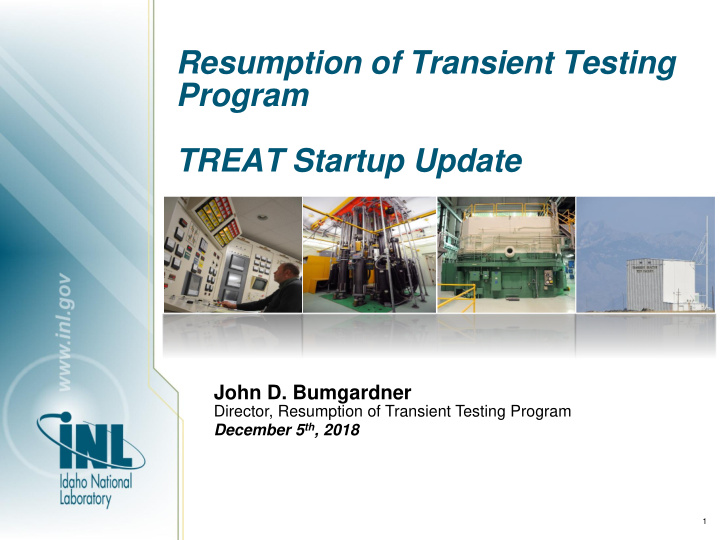



Resumption of Transient Testing Program TREAT Startup Update John D. Bumgardner Director, Resumption of Transient Testing Program December 5 th , 2018 1
Facility Location 2
Nuclear Fuels Development Requires Transient Testing for Design Development and Qualification Nuclear fuel tends to fracture during use or when exposed to a power burst, it is important for the fuel to retain reasonable structural integrity During a transient test, fuel is exposed to a Transient testing fuel and crash power to cooling testing cars have a lot in mismatch, driving the fuel common: Design and test for to high temperatures high safety standards 3
Fuel Development Cycle
TREAT Reactor Top of the Reactor • Designed to conduct transient testing of fuels and structural materials. • Operated from 1959 to 1994. • Reactor has performed 6604 reactor startups, 2884 transient irradiations. • Major refurbishment completed in the late 1980’s, and upgraded reactor ran from 1989 to 1994. • Reactor remained fully fueled during standby from 1994 to now, plant left in excellent condition with all required surveillance and maintenance activities performed. • Over 20 GW Peak Transient Power (120 kW Steady-state power). • Core: 4 ft. high x roughly 6 ft. dia.; surrounded by 2 ft. graphite reflector. • Fuel: 19 x 19 array (approximately 360 fuel elements) of 4 in. X 4 in. fuel and reflector assemblies. • LEU conversion work initiated. South View of the Reactor 5
TREAT Configuration and Unique Features • No decay heat mitigation actions required – Negligible decay heat – Low fission product inventory – No emergency cooling or residual heat removal required – No emergency power required • Self-limiting – Near instantaneous large negative temperature coefficient – safely shuts the reactor down, inherently safe – Reactor Trip System is not required to prevent fuel damage • Reactivity Control and Operation – Prompt critical operation – normal mode – Air cooling system has a non-safety- related function – operated during steady-state operations or to prepare for next transient – Three independent Control Rod Drive types – Transients performed from remote Control Room – Self-contained experiments 6
RTTP Recap and Highlights • Managed as a reactor being returned to service following an extended outage. • Relied on operations and maintenance history and experienced operating personnel. • Required activities completed for restart include: – Systematic approach used to return facility systems and equipment to service. – Procedures and processes revised to current standards. – Hired and trained full operating staff. – Thoroughly tested and exercised all equipment and systems supporting reactor operations. • Extremely good safety record with no significant injuries. • Resumption of Transient Testing Program (RTTP) was completed August 31, 2017, more than twelve months ahead of the baseline schedule of September 2018 and for about $20M less than the baseline cost estimate of $75M. • On November 14, 2017 the Reactor critical operations resumed after over two decades of standby.
TREAT Restart Timeline Mission need approved for transient testing 2011: In February NEPA process completed and FONSI approved, TREAT 2014: selected as the reactor to perform transient testing After February initiated assembling restart team, initiated 2014: infrastructure items such as facility cleanout, roof replacement, initiated system walkdowns Revised and implemented SAR and TS to allow control rod and in 2015: core activities, DOE RA performed, system testing initiated, facility repairs and refurbishment under way Poisoned core and validated, replaced Transient Rod shock 2016: absorbers, completed plant significant modifications, initiated integrated plant simulated operations 2017: Completed all personnel, plant, and process preparations, initiated and completed review processes, low power testing initiated 2018: Physics testing, completion of restart plan, initiate experimental operations ~ March 2018 8
Equipment Readiness Journey 9
Future of TREAT Operations • The Reactor will continue to be operated through 2017 at low power for startup testing. • Experiments and testing of new cutting edge instruments is expected to commence in calendar year 2018. • There is great interest in use of TREAT, anticipated customers and research are under development • Dan Wachs is giving a Transient Testing experiment presentation later in the meeting. 10
The National Nuclear Laboratory 11
Fuel Assembly • Standard Fuel Assembly – Central uranium oxide-bearing Fuel Section – Upper and lower Graphite Reflector Sections • Fuel Section – Standard is 4 feet long, contains six 8 inch long fuel blocks, specialized use less fuel – 1 part HE UO 2 to 10,000 parts carbon/graphite – 37g HE UO 2 per fuel element – Clad in Zr-3, under vacuum • Carbon and Graphite Urania Fuel – High heat-absorption capability provides heat sink for transient heat without cooling dependence. – Homogeneity of fuel and moderator provides near instantaneous large, Fuel Configurations negative temperature coefficient. – Excellent thermal shock resistance sustain high rates of heat input during transient operation. – Less than 0.3% burnup on existing fuel, indicating remaining fuel life well in excess of the 40 year programmatic projected need. • Graphite Reflector Sections 1 – 2 feet long each 2
Recommend
More recommend